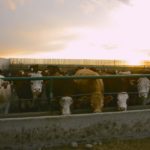Compared to last week, western Canadian feeder cattle prices were unchanged to $2 higher on average. Feeder cattle markets appear to have divorced from the fed cattle complex and calves are now reaching levels not seen since November last year. Feedlot operators were fairly aggressive on all weight categories under 900 lbs., but heavier yearlings […] Read more

Klassen: Feeder market stabilizes on lower supplies

Klassen: Feeder market undergoes minor recovery
Compared to last week, western Canadian yearlings sold $3 to as much as $6 higher while calf markets were relatively unchanged. Feeder cattle futures experienced a $5-$7 rally, which quickly renewed optimism in the cash trade. Ideas that yearling supplies will drop below year-ago levels on both sides of the border this August spurred on […] Read more

Klassen: Seasonable temperatures enhance feeder market
Western Canadian yearling markets were actively trading $2-$5 above week-ago levels while prices in the Lethbridge area were up a solid $5 to as much as $10 in some cases. Improving pen conditions, along with a stronger fed cattle market, resulted in a surge of buying interest from southern Alberta operations. Orders from Feedlot Alley […] Read more

Klassen: Feeder market stabilizes
Compared to last week, western Canadian feeder cattle prices were relatively unchanged. Stronger export demand appears to be supporting the market in Manitoba and certain pockets in Saskatchewan; however, Alberta feedlot interest remains subdued. Adverse weather continues to plague southern Alberta. Snow and freezing temperatures followed by brief melting periods have resulted in very poor […] Read more

Klassen: Rising feed grain prices weigh on feeder market
Western Canadian yearling prices were relatively unchanged from week-ago levels; however, feeder cattle fit for grass and calves dropped $4 to as much as $10 from seven days earlier. Rising feed grain costs appear to be affecting lighter weight categories more than the yearling market. Feedlots will be struggling with negative margins through the summer […] Read more

Klassen: Buyers’ temperance subdues feeder market
Compared to last week, western Canadian yearling prices were under pressure trading steady to $3 lower; however, eastern Canadian orders were prevalent in Manitoba and eastern Saskatchewan, where values were relatively unchanged from week-ago levels. Alberta feedlot demand was subdued as the deferred live cattle futures traded to three-month lows. Most operations are holding high-priced […] Read more
Klassen: Feeder market sends mixed signals
Compared to last week, western Canadian average yearling prices were steady to $3 lower while heavier replacements above 1,000 lbs. actively traded $3 to as much as $6 lower. Weakness in deferred live cattle futures, along with rising feed grain prices, caused buyers to lower their bids accordingly. Steers averaging 1,000 lbs. were readily trading […] Read more

Klassen: Feeder cattle prices gaining momentum
Compared to last week, western Canadian yearling prices were steady to $4 higher while calves and grass cattle markets were relatively unchanged. Once again, there was a wide range of prices across the Prairies as feedlots adjust to higher feed grain prices. Secondly, buyers were quick to discount fleshier cattle; backgrounded calves fed too much […] Read more

Klassen: Feeder cattle markets absorbing price uncertainty
Western Canadian feeder cattle markets were quite variable throughout the week due to the uncertain price structure in the deferred position. Yearling prices differentiated by nearly $15 across the Prairies while lighter calves were relatively unchanged from week-ago levels. Adverse weather throughout January and February has tempered demand for replacement cattle. Southern Alberta has received […] Read more

Klassen: Stronger fed cattle prices jolt feeder market
Feeder cattle markets came alive last week as fed cattle prices took a fortuitous bounce. Alberta packers were buying fed cattle in the range of $276-$279 on a dressed basis, up approximately $4 from week-ago levels. Improving beef demand enhanced wholesale beef prices, which quickly spilt over into the cattle complex. Compared to last week, […] Read more

